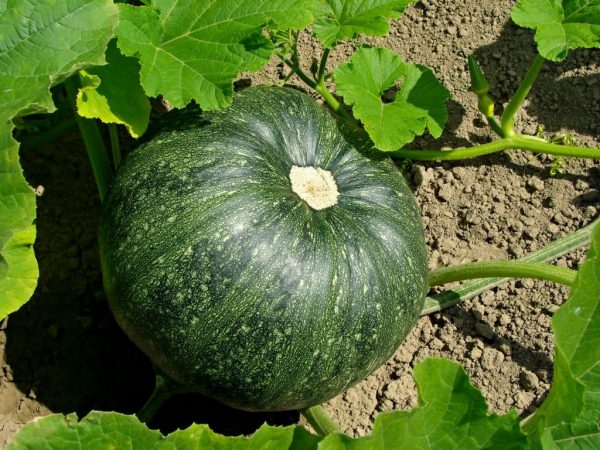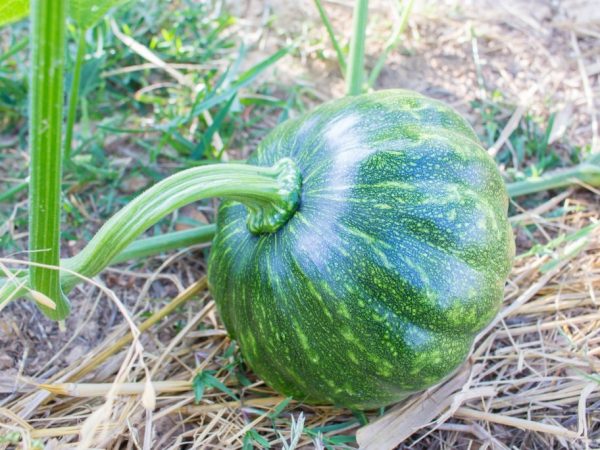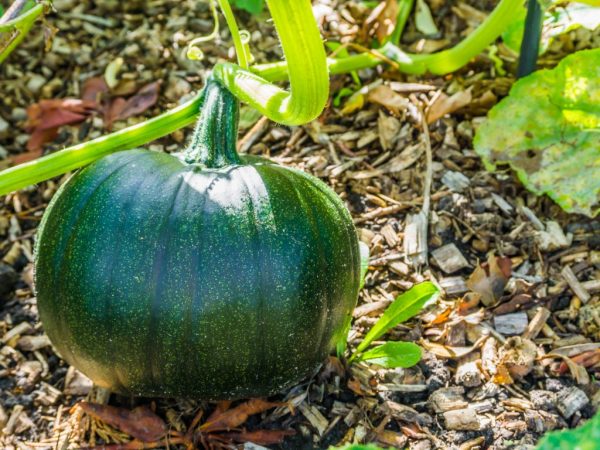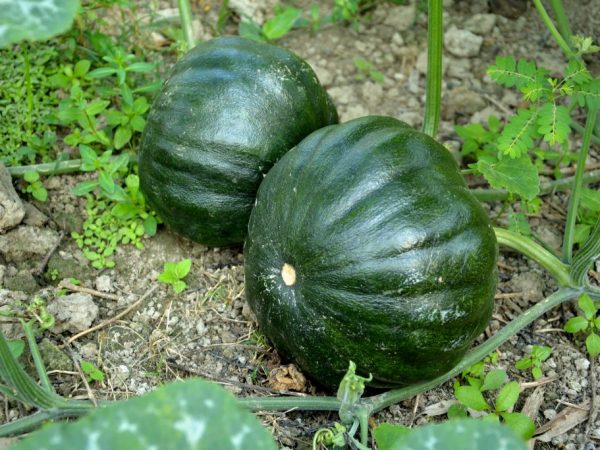Popular varieties of green pumpkin
The pumpkin family includes a wide variety of varieties that differ in size and color of fruits, taste and ripening times.

Popular varieties of green pumpkin
Green pumpkin is one of the unusual varieties that is preferred to be planted as an ornamental variety. Some of its types are not inferior in taste to the classic pumpkin.
Description of green varieties
Green pumpkin is a herbaceous plant. This species often grows along fences and fences, and it clings to them through antennae.
She usually has large, dark green pentahedral leaves. There are small thorns on the surface of foliage and shoots. The length of the lashes creeping along the ground is up to 5-8 m.
Ornamental fruits are small, the size of a pear or apple, but in some varieties, the weight reaches 10-15 kg.
A characteristic feature is the color of the fruit - it is a contrasting green, but the surface of the pumpkin is different - smooth or rough. The pulp is a classic yellow-orange color.
Hardcore species
Hard-barked pumpkin is not capable of providing gastronomic qualities at the proper level, because it does not differ in sweetness.
It is more often raised as fodder to feed livestock.
The shelf life is much shorter in comparison with other types. However, it has a number of advantages:
- quick ripening times, allowing you to get harvests by the end of summer - the very beginning of autumn;
- some species are gymnosperms;
- the seeds differ in their taste.
There are several popular varieties.
Gribovskaya-189
The pumpkin is early ripe, yields a harvest after 85-95 days from the moment of planting in open ground. Outwardly, it is similar to a vegetable marrow.
The pumpkin bush is compact, the whips are short. Vegetables grow elongated, the average weight is 2.5-5 kg.
The color of the peel is dark green, however, when stored in a warm room, it changes color to yellow. Pumpkin pulp of classic yellow color, without any special taste.
Freckle
Freckle is one of the bush pumpkin species that ripen in a short period of time, gives the first harvest after 90-100 days after planting. The shape of the vegetables is rounded and flattened.

The variety will delight you with an early harvest.
Average weight - 0.8-2 kg. The color of the bark is light green with pale yellow specks - freckles. From where the variety got its name. The pulp has a pear tinge aftertaste.
Freckles are preferred by gardeners in regions with an unfavorable climate and frequent temperature extremes. this pumpkin is resistant to low temperatures.
Miranda
Miranda belongs to the hard-bore species with an average ripening period, give the harvest in 100-110 days after planting in the ground. Semi-bushy variety with medium-length lashes.
The surface of the vegetables is covered with spots of gray-light green color. The shape of the fruit is round. Average weight - up to 4 kg. Gymnosperms, seeds without shell in large quantities.
Acorn
The hard-bore Acorn species is early maturing. Technical ripeness occurs 85-90 days after planting.
Produces small fruits weighing up to 0.8 kg, resembling dark green acorns in appearance. The taste of orange pulp is more similar to zucchini.
Muscat species
Muscat varietal varieties are characterized by high palatability, with a nutty aftertaste.
Vitamin
Among the green bush varieties - Muscat Vitamin pumpkin. Refers to late ripening, fully ripening in 140 days. It is thermophilic, requires a sufficient amount of sunlight. The crop can be stored for a long time.
It is characterized by a high content of sugar and carotene, therefore it is mainly used for preparing first and second courses, cereals and desserts.
Fruits are round, slightly flattened, ribbed. Average weight - 7-8 kg. The rind is dark green in color.
Mirani di Chioggia
The Muscat variety Mirani di Chioggia produces large fruits weighing up to 7 kg. However, vegetables have an unattractive appearance - a ribbed-pimpled crust of a dark green color makes them look like uneven balls.
In this form, there are practically no voids, the structure of the pulp is fleshy. The variety is late-ripening, ripening in 4-4.5 months, but compensates for this disadvantage with an increased shelf life.
Augustine

Fruits can be kept fresh for a long time
Mid-season Augustine's butternut squash yields its first vegetables in 105-110 days. In a long-leaved plant, the fruits are elongated with an extension on one side in the area of the flower scar. The surface of the bark is smooth, dark green in color, with a faint white-gray waxy coating.
The average weight of vegetables is 4-6 kg. Has a short shelf life, providing taste and presentation only for 3 months.
Family
Butternut family gourd takes 130-135 days to ripen. Fruits are elongated, long, dark green in color with a slight gray-light green waxy bloom. Average weight 8-16 kg.
Differs in resistance to low temperatures, at the same time it withstands short-term drought well. Shelf life is 2 months.
Large-fruited species
Gardeners love large-fruited varieties because these species have practically no flaws. They give good yields, vegetables grow in large sizes (from 7-8 kg and more) and perfectly retain their external qualities and useful properties for a long time during storage.
Dawn
Large-fruited Dawn ripens in 105-115 days, refers to mid-ripening climbing plants. Round-shaped, flattened vegetables. Average weight 7.0 kg. The peel is gray-green, segmented, with yellow and pinkish spots.
Pumpkin pulp contains an increased amount of carotene, is slightly juicy, sweet.
Dawn is resistant to powdery mildew and bacteriosis.
Khutoryanka
The mid-season type Khutoryanka gives the first harvest after 120-130 days from the moment of planting. It is a climbing plant. The vegetables grow in an oblong cylindrical shape with a dark color. Average weight - 7-10 kg.
Farmers appreciate the gardeners for their resistance to low temperatures and good transportability.
Hubbard
The Hubbard varietal variety belongs to large-fruited and at the same time nutmeg, gives large fruits weighing up to 10 kg after 110-115 days from the moment of disembarkation. The pumpkin pulp is dry and crumbly with a characteristic nutty aftertaste.
Sweet species

Sweet varieties contain a lot of carotene
Sweet varietal species grow small in size, but are distinguished by high gastronomic qualities, inherent sweet taste and high carotene content.
Sweetheart
An early ripe species of Slasten ripens 85-95 days after planting. It is a climbing plant. The vegetables are round. The bark is smooth, segmented, dark. The average fruit weight is up to 6 kg.
It is distinguished by a high content of carotene and pectin in the sweet pulp, which ensures good taste.
Among other advantages - the shelf life increased to 9 months while maintaining the original presentation. During cultivation, resistance to drought and high temperatures was noted.
Barn
The mid-season Barn gives the first harvests after 110-115 days from the moment of planting. A weakly plaited plant with rounded fruits, the bark of which is dark green in color and covered with black spots or white-striped.
The average fruit weight is 2-4 kg.
The main advantage of the variety is the increased content of carotene and the juiciness and sweetness of the pulp inherent in sweet pumpkin species. It is well stored without loss of useful properties throughout the winter.
Azure
Mid-season Azure ripens in 100-125 days. The plant is long-leaved. Vegetables grow 4-5 kg, the shape is flattened, the color of the bark is gray with greenish and brown. Pumpkin pulp is characterized by increased sweetness.
Decorative views
The main purpose of decorative greenfinches is to decorate the backyard territory.
These plants are part of landscape design and are used to decorate gazebos, fences and fences.
The fruits are usually of unusual sizes and shapes, and the bark is often decorated with stripes, shading and specks. The crop is removed until fully ripe, dried, in order to be subsequently used as decorative elements.
Goose with apples is the most popular variety. It is not used for food purposes.
Pear-shaped fruits. Outwardly, they resemble birds with elongated necks, because have an end narrowed on one side in the form of an elongated neck.
The bark is green with light blotches of various shapes. The foliage of the plant is velvety, which makes it even more decorative. ...
Conclusion
Green varietal varieties of pumpkin are divided into several directions: hard, sweet, nutmeg, large-fruited and decorative. Most of them are eaten.
Only decorative varieties are mainly grown to decorate the personal plot and use their fruits as decorative items.

